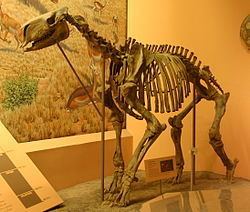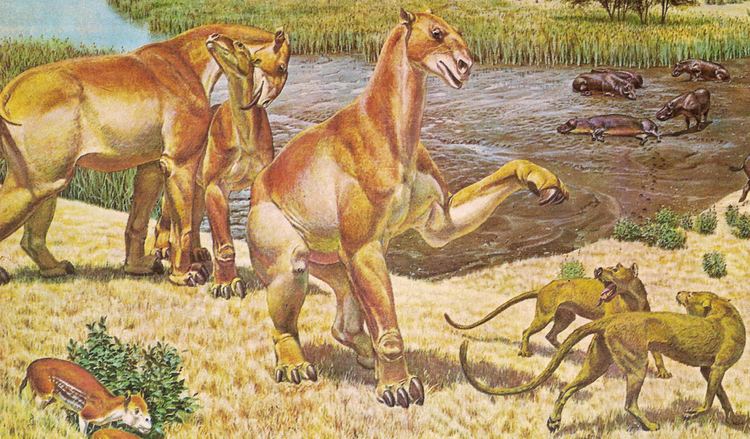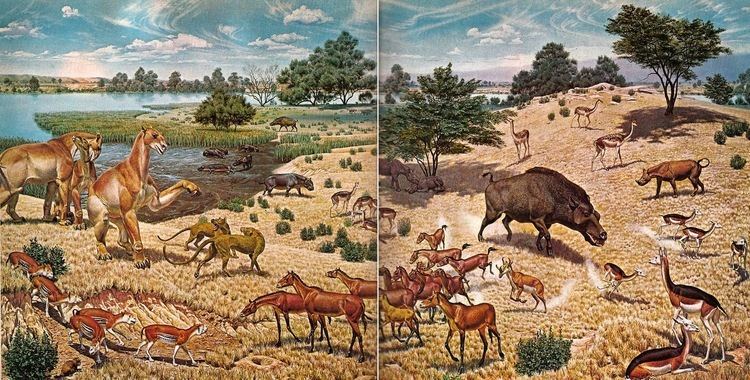Kingdom Animalia Superfamily †Chalicotherioidea Subfamily †Schizotheriinae Phylum Chordata Rank Genus | Suborder †Ancylopoda Family †Chalicotheriidae Scientific name Moropus Higher classification Schizotheriinae Order Odd-toed ungulate | |
 | ||
Similar Chalicothere, Mammal, Ancylotherium, Chalicotherium, Daeodon | ||
Moropus (meaning "slow foot") is an extinct genus of perissodactyl ("odd-toed") mammal that belonged to the group called chalicotheres, which were endemic to North America during the Miocene from ~23.0—13.6 Mya, existing for approximately 9.4 million years.
Contents
- Review 79 collecta deluxe moropus
- Taxonomy
- Morphology
- Fossil distribution
- M elatus
- M hollandi
- M matthewi
- M merriami
- M oregonensis
- M senex
- References

Review 79 collecta deluxe moropus
Taxonomy

Moropus was named by Marsh (1877). Its type is Moropus distans. It was synonymized subjectively with Macrotherium by Osborn (1893). It was assigned to Moropodidae by Marsh (1877); to Chalicotheriidae by Marsh (1877), Peterson (1907), Skinner (1968), Coombs (1978), Carroll (1988), Coombs (1998) and Holbrook (1999); and to Schizotheriinae by Geraads et al. (2007).
Morphology
Like other chalicotheres, they differed from their modern relatives in having large claws, rather than hooves, on the front feet; these claws may have been used for defense or digging for food. Moropus stood about 8 feet (2.4 m) tall at the shoulder. The three highly compressed claw-like hooves on each foot were split down the middle. These claws actually gave Moropus its name: "slow (or sloth) foot". This name implies that because of the claws, Moropus was a clumsy mover. But the articulation of the phalangeal (finger) bones, in addition to the likely presence of large foot and toe pads, shows that Moropus probably could raise the claws slightly to enable it to move about quite smoothly. As the hooves curved inward, it probably had a pigeon-toed gait.
Fossil distribution
M. elatus
M. elatus was named by Marsh (1877).
Body mass
Two specimens were examined by M. Mendoza, C. M. Janis, and P. Palmqvist for body mass.
Fossil distribution
M. hollandi
M. hollandi was named by Peterson (1907).
Fossil distribution
M. matthewi
M. matthewi was named by Holland and Peterson, 1913-1914.
M. merriami
M. merrami was named by Holland and Peterson (1914). It was recombined as Macrotherium merriami by Matthew (1929) and Stirton (1939); it was recombined as Chalicotherium merriami by von Koenigswald (1932).
Fossil distribution
M. oregonensis
M. oregonsis was named by Leidy 1883. It was named by Leidy (1883) and recombined as Moropus oregonensis by Holland and Peterson (1914) and M. C. Coombs in 1978 and 1998, and also by M. C. Coombs, R. M. Hunt, E. Stepleton, L. B. Albright, III, and T. J. Fremd.
Body mass
Two specimens were examined by M. Mendoza, C. M. Janis, and P. Palmqvist for body mass.
Fossil distribution
M. senex
M. senex was named by Marsh (1877). It was considered a nomen dubium by Coombs (1978) and Coombs (1998).
